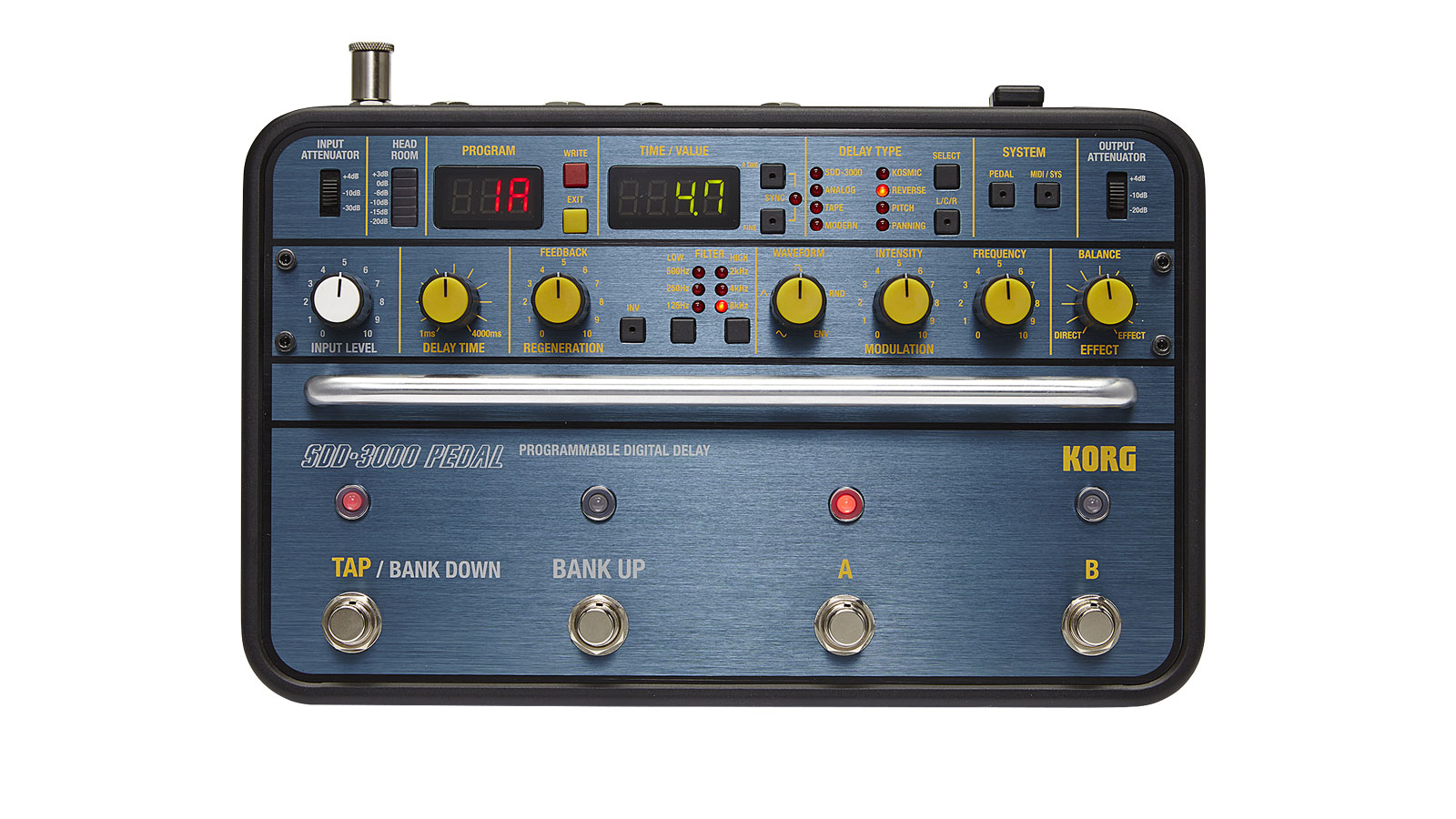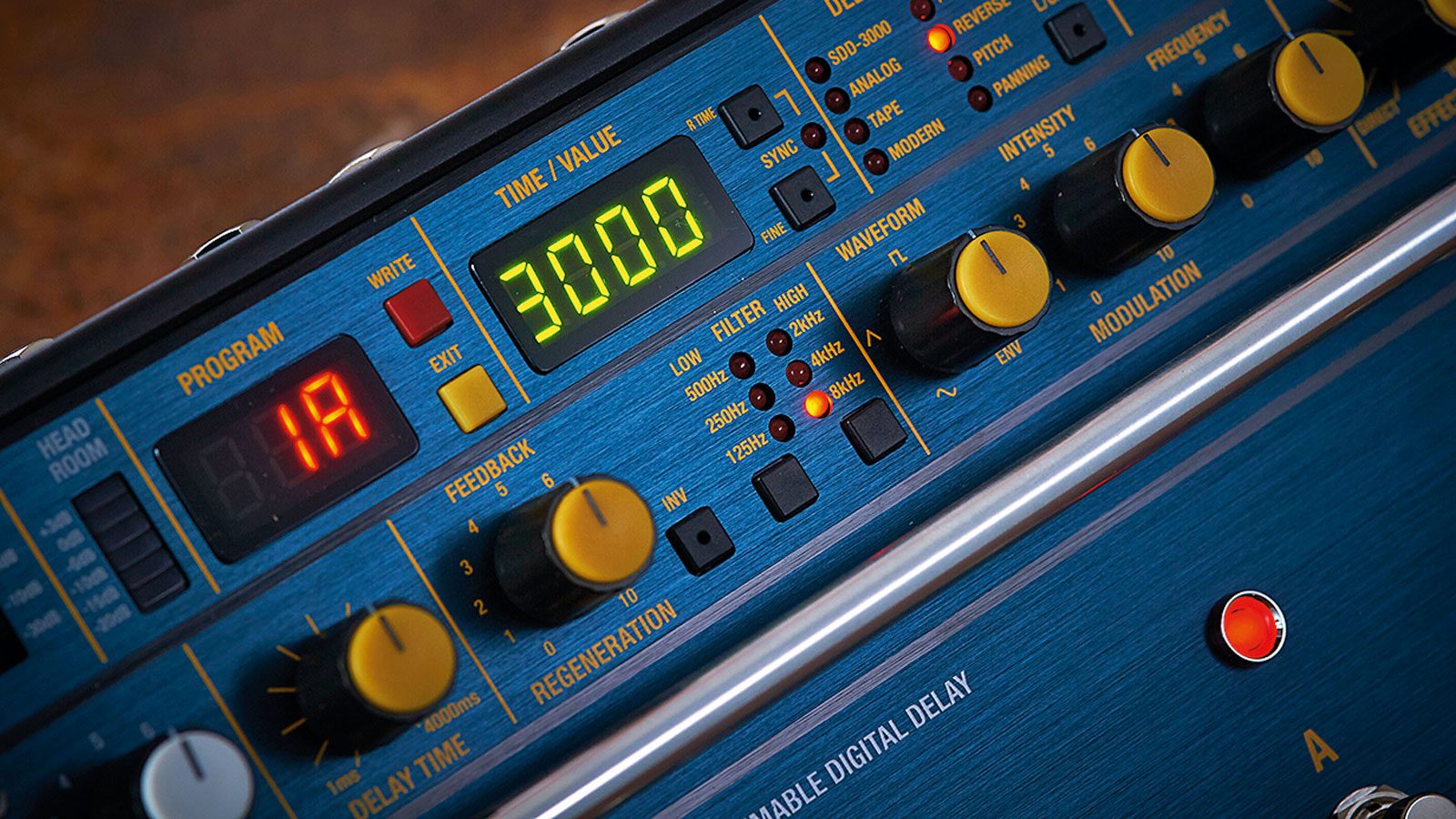MusicRadar Verdict
A classic name revived with modern options.
Pros
- +
Delay sounds excellent. Comprehensive modulation section. Preamp/boost is great. Seamless changeover between settings. Wide variety of delay effects.
Cons
- -
Requires proper programming (and, ideally, two amps) to get the most from it. Price.
MusicRadar's got your back

Korg SDD-3000 Pedal

Delay types
Korg's long-discontinued SDD-3000 digital delay is a rack unit with pedigree that has been in demand from guitarists wanting to partake of its mojo, but tracking down a vintage unit is as expensive as it is tricky.
Delay fans rejoice, then, as Korg has made things far simpler with the creation of the new SDD- 3000 Pedal, which puts the essential functionality of the original into a large stompbox, while adding some new features that ought to appeal to a wide range of players.
The new pedal is based around a set of 80 programs in 40 banks of two. Dedicated footswitches are available for bank up, bank down and the two presets. The bank down doubles as a tap tempo switch that can be used to set the time directly in milliseconds or in sync mode, where you can specify the delay time as a note value if you fancy a little bit of rhythmic dotted eighth-note action.
"Korg has loaded the pedal with eight types of delay - representing the original SDD- 3000 sound, tape and BBD emulations, reverse and more"
Korg has loaded the pedal with eight types of delay - one representing the original SDD- 3000 sound, the others offering tape and BBD emulations, reverse and more. There are knobs for setting the blend of dry and effected sound, and for dialling in the delay time (any value from 1ms to 4000ms) and delay feedback (the number of repeats).
If you are using the unit in stereo you can set different delay time and feedback values for the left and right channels. On top of that, there's the L/C/R switch, which creates multi-tap delays that output to the left, centre and right, and there's a ducking function that lets you apply delay only when the input is at a low level.
One of the great assets of the original machine was its comprehensive modulation section, and this is reproduced here with intensity and frequency knobs, plus a choice of five basic modulation waveforms (sine wave, triangle, square, random and envelope). These can be dialled in with a continuously variable knob that also allows blends.
It's an obvious update to the original, as Korg designer Dave Clarke observes, "We have assigned the waveform shape to a knob, rather than a slider, as this means you're able to create cool waveform shapes because the sine morphs into the triangle and the triangle morphs into the square, et cetera."
Likewise, the original's EQ for the repeats, with three different filter settings each for high and low frequencies, is all present and correct but taken care of in the digital domain using DSP that "gave us greater scope to recreate the tone everyone expects," Dave notes.
Another valued feature of the original SDD-3000 is its preamp, which has spawned several unofficial stompbox clones. Again, Korg has remained true to the original preamp circuit, but is using modern components that it believes are "able to recreate the unmistakable tone with modern-day reliability," adds Dave.
The new pedal offers the original's input and output attenuator switches, the +4 output setting offering an opportunity to drive your amp harder, that players have taken advantage of over the years, too.
Sounds
The SDD-3000 Pedal is robustly stage-ready, featuring a raised metal bar to protect the knobs. Separate highly-visible displays show the program number (in red) and the delay time (in green). Calling up programs is instantaneous, and changing between them can be seamless, as you can set the repeats from the previous program to carry over.
An initial trawl through the factory programs shows what the unit is capable of, as Korg has programmed in a wide range of delays and some modulation effects: flanging, chorus and more can be dialled in using the appropriate short delay times in tandem with the modulation section's knobs.
Of the delay types available, the SDD-3000 type offers an accurate take on the original vintage unit's sound, as opposed to the Modern type, which offers a typically cleaner digital delay. The Analog and Tape types offer a different character in the repeats: Analog delivers a degree of Bucket Brigade-style degradation in the repeats, while the Tape style yields a smoother decaying vibe.
"The SDD-3000 Pedal has a great sound and can make a contribution to your tone, even when bypassed"
Kosmic offers strange ambiences by applying pitch changes, and delivers a great line in reverbs, including variations on that popular shimmer reverb. Pitch puts a pitch shifter in front of the delay for some tuned repeats, while Reverse and Panning do exactly what you'd expect them to do.
Getting your delays to fit your sound may start by choosing a delay type, but gets a helping hand from the hi- and lo-cut filters, where you can choose to keep the fuller bandwidth repeats or soften up their edge and/or thin out their girth. Add some modulation and there are myriad variations, whether it's using a sine wave to add chorus or the Random setting for simulating the natural fluctuations of tape echo.
The SDD-3000 Pedal has a great sound and can make a valid contribution to your tone, even when bypassed: that +4dB option works like a good boost pedal into your amp. In standard mono in/mono out, guitar and one amp setup, the pedal does a fine job of providing a wide range of delay, ambience and modulation effects; but it really comes alive in a setup using a pair of amps (or in stereo recording), especially as you can set different but related delay times for each sound.
It's the sort of unit you need to program in advance before taking it onstage - the user interface may be a bit fiddly in that environment - but the well-implemented footswitching will give you access to everything you need. And if your drummer starts the song at the wrong speed, you've at least got tap tempo...
There will be many who are very glad to see the SDD-3000 back and in such a practical and user-friendly form, too. But looking beyond the historical aspect of the unit, what you are getting is one extremely versatile and classy delay pedal that could take care of all your stage and recording needs, albeit at a pro-level price.
Trevor Curwen has played guitar for several decades – he's also mimed it on the UK's Top of the Pops. Much of his working life, though, has been spent behind the mixing desk, during which time he has built up a solid collection of the guitars, amps and pedals needed to cover just about any studio session. He writes pedal reviews for Guitarist and has contributed to Total Guitar, MusicRadar and Future Music among others.










